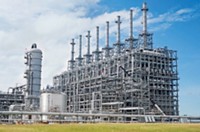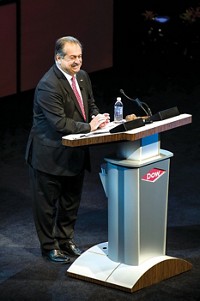Advertisement
Grab your lab coat. Let's get started
Welcome!
Welcome!
Create an account below to get 6 C&EN articles per month, receive newsletters and more - all free.
It seems this is your first time logging in online. Please enter the following information to continue.
As an ACS member you automatically get access to this site. All we need is few more details to create your reading experience.
Not you? Sign in with a different account.
Not you? Sign in with a different account.
ERROR 1
ERROR 1
ERROR 2
ERROR 2
ERROR 2
ERROR 2
ERROR 2
Password and Confirm password must match.
If you have an ACS member number, please enter it here so we can link this account to your membership. (optional)
ERROR 2
ACS values your privacy. By submitting your information, you are gaining access to C&EN and subscribing to our weekly newsletter. We use the information you provide to make your reading experience better, and we will never sell your data to third party members.
Business
A Weak Economy Forces Dow To Retrench
CEO explains why company must scale back some of its more ambitious growth initiatives
by Alexander H. Tullo
January 28, 2013
| A version of this story appeared in
Volume 90, Issue 51
CLARIFICATION: This story was updated on Dec. 20, 2012, to mention that in addition to Dow Chemical’s stock price falling 3.3% on Dec. 3, the Standard & Poor’s chemical index fell 1.9% on the same day.
Dow Chemical’s chief executive officer, Andrew N. Liveris, isn’t as optimistic as he once was.

In 2009, Liveris had just guided the company through the financial crisis and Great Recession, all while digesting its purchase of specialty chemical powerhouse Rohm and Haas. The “new Dow,” armed with enormous economies of scale and its widest-ever breadth of technical expertise, seemed ready to conquer any market it coveted. Solar panels, lithium batteries, and polymers made from ethanol, though new to Dow, were targets every bit as legitimate as the packaging, paint, and construction materials that had always been at the firm’s core.
But at the time, Liveris thought the global economy had nowhere to go but up. He hadn’t expected four years of sideways slippage.
Faced with slumping revenues and earnings, Liveris is now cutting back. In October, Dow announced it will lay off 2,400 workers—5% of its workforce—and shut down 20 plants. And reversing its stance of only a few years ago, the company is cutting future-oriented spending by about $1 billion in total. Mostly this will come from capital projects, but R&D will not be spared the ax. Dow also plans over the next two years to divest underperforming businesses that together generate $1 billion in annual sales.
At an investor forum in New York City on Dec. 3, Liveris tried to justify such measures to reporters, investors, and analysts. Dow didn’t change, he maintained. The rest of the world did by slowing almost to an economic halt.
A big problem for Dow has been the European debt crisis, which has been worsening since mid-2011 and has dragged the region into recession. This year, Dow has lost $2 billion in sales as a result of falling prices; about half of that came from weakening foreign currencies such as the euro. Some of Dow’s biggest plant closures—a polyethylene plant in Belgium and a sodium borohydride plant in the Netherlands—are set for Europe.
China has also emerged as a big culprit behind sluggish economic growth. The country’s transition to a new president and Politburo has bred economic turbulence. Growth rates in the country have slowed from 8–10% to 6–7%. “We have been used to double-digit growth rates in plastics in China for the better part of a decade,” Liveris told reporters. “That’s slowed or stopped in this last six months.”
In all, Dow is planning $1.75 billion in new spending cuts. Of the $1 billion in future spending cuts, about $800 million will come from capital expenditures and about $100 million each from R&D and other discretionary spending.
Liveris emphasized how careful Dow is being about the measures. “You don’t want to cut into muscle and bone,” he told reporters. As its guideline, the company is cutting programs that won’t generate profits until the end of the decade; it is keeping projects that promise high returns sooner.
For example, Dow is halting investment in Dow Kokam, its new lithium-ion battery joint venture in Midland, Mich., because the market for electric vehicles has fizzled. Similarly, the company is closing a plant in Midland, that makes its Aerify diesel particulate filters because of lack of demand. Dow also won’t proceed further with its plan to make polyethylene from ethanol in Brazil.
In contrast, growth initiatives in electronics—such as dopants used in the organic light-emitting-diode displays of smartphones—are starting to pay off. Liveris said Dow has been successful in its Powerhouse solar shingle program and will keep that Midland plant open.
And Dow’s expensive initiatives in traditional chemicals and plastics are proceeding as planned. These include investments meant to take advantage of the U.S. shale gas boom, such as the restart of an ethylene cracker in St. Charles, La., and the construction of ethane cracking and propane dehydrogenation units in Freeport, Texas. Dow’s $20 billion Sadara joint venture with Saudi Aramco is also making progress.
Even with the cuts, Liveris said he wants to keep Dow’s scientific staff intact. When asked whether he will lay off chemists, Liveris responded, “Not to my knowledge. We are pretty much redeploying people. Scientists are precious. You bring them in, you train them, you redeploy them.”
He added that the company wants to attract more scientists. For example, Dow is moving researchers from a former Rohm and Haas laboratory in Spring House, Pa., to a newer, former Pfizer site in nearby Collegeville. “Finally, our scientists in the Philadelphia area are getting modern facilities,” he said, positing that Dow could “attract the best scientists on the East Coast.”
Despite Liveris’ best effort, investors weren’t excited about what they heard at the New York City forum. The company’s stock price tumbled 3.3% that day to $29.30 per share. The Standard & Poor’s chemicals index fell 1.9% on the same day.
But analysts did seem pleased that Dow is holding on to its key initiatives and positioning itself for an economic recovery. “Dow took its lumps in 2012, including plant outages, a pronounced slowdown in China, and somewhat disappointing execution as performance fell short of its own milestones for a severe recession,” wrote Citi Research analyst P. J. Juvekar in a note to clients. “After having underperformed in 2012, we see upside for Dow in 2013.”




Join the conversation
Contact the reporter
Submit a Letter to the Editor for publication
Engage with us on Twitter